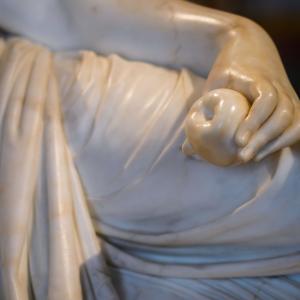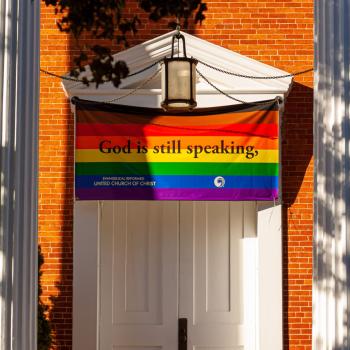One of the most powerful forms of idolatry is the tempting power of humanity’s own creativity. Consider the words of one of the greatest artistic minds in history:
Hier sitz ich, forme Mensche
Nach meinem Bilde,
Ein Geschlecht, das mir gleich sei,
Zu leiden, zu weinen,
Zu genießen und zu freuen sich,
Und dein nicht zu achten,
Wie ich!
Behold
Here I sit, fashioning men
In my own image,
A race after my likeness,
A race that will suffer and weep,
And rejoice and delight with heads held high
And heed Your will no more
Just as I!
Johann Wolfgang von Goethe, Prometheus
Goethe himself has often been lauded as Germany’s greatest literary artist, a false attribution of “GOAT” status, to be sure, although an understandable one. However, Goethe captures something powerful about human genius, and human audacity, in these classic lines. In Prometheus, the artist sits in the role of God as creator, fashioning a world according to his own human powers of generative thought–a world made in his own image, a human image. The human creator is distraught with God–here the biblical God–due to the problem of evil and suffering and the classically pagan idea that God himself is but a product of time and fate or, as D.H. Lawrence once put it, of “the eternal god-stuff that roars.”
For the poet, the inhabitants of this humanistic world are not necessarily better off than those made by God. Just because humans are made only by other humans, both biologically and socially, does not mean that humanity’s offspring won’t suffer. However, like the poet himself, these new humans will be fashioned in such a way as to reject the possibility of God, and they will do so in favor of the image of their own self. As such, Goethe, whether implicitly or explicitly, points to humanity’s own creative power as the source of its idolatry and, indeed, its own demise.
Romanticism: The Replacement Religion
In the throes of the Enlightenment’s rationalist critique of religion, 18th and 19th century Romantics made a compelling attempt to alleviate the emerging existential crisis in Western culture. Engaging with man’s deep yearning for transcendence had always been under the provenance of religion, particularly Christianity. However, modern Europeans found this no longer tenable. Into the gap stepped philosopher-poets like Goethe and Schiller on the continent and Shelley, Wordsworth and Blake in England. These new priests sought a different ground for the transcendent longing in man, aiming to bridge the chasm between the individual soul and the disenchanted world.
These and others wanted to salvage some objective and unconditioned meaning for a humanity too fragile to survive the cold, harsh scrutiny of the natural sciences, and its attending philosophical atheism, while, at the same time, feeling the need to unmoor human nature from the constraints of revealed religion with its speculative metaphysics and apodeictic moral injunctions.
For the Romantics, this new transcendence should be grounded in the universal, aesthetic sense of awe at the majesty of nature and the vastness of time. Moreover, there was a renewed emphasis on man’s capacity to give expression to that sense. Artistic endeavor, therefore, became for this alternative spirituality the medium through which man could pull himself up by his bootstraps and face the new dawn of the modern world. Through art man might be saved from the terror of meaningless existence and moral cruelty.
Charles Taylor summarizes this Romantic undertaking speaking of Schiller and Goethe’s
attempt to find a weighty enough meaning to life in human terms, within the agent, and within nature. One form in which this came to be defined…was through an ideal of harmonious unity. This would be both like and unlike Plato’s: the crucial difference is that it would not involve rising beyond or sublimating ordinary natural desires. But operating fully in their ordinary forms, as sexual love, or enjoyment of beautiful surroundings, they would be transfigured by the sense of their higher significance.
Taylor, A Secular Age, 313
Since the 18th century especially, discerning the “harmonious unity” between man’s “true nature” and the external rhythms of the cosmos, and exploring how one might articulate this harmony in new and variegate ways, has operated as a form of religion. Romanticism has acted as a substitute for the historically contingent religions, according to the Romantics, of Judaism and Christianity. The idea was to recover a more ancient, and universal, spirituality. Or so it was hoped.
Poetry and Art as The New Religion of Human Creativity
For the Romantics, recognizing natural beauty, to include the beauty of desires and longings natural to us, was not enough. Expressing that beauty in creative action, or what Schiller called Spiel (play), is what allows men to exceed the limits of institutional faith. Creative expressions of nature allow us to know more fully man’s true purpose. In addition, this undertaking further enables us to develop a deeper moral sense (Taylor, 313). The mechanism of this new humanist project is poetry, or aesthetics more generally. Aesthetics would be the key for future societies to both experience pleasure on the one hand while improving ethically on the other.
This romanticism, with its hopeful humanism and moral self-righteousness, is, to this day, still in competition with a Judeo-Christianity that demands specific metaphysical commitments and claims (the Creeds) along with revealed moral injunctions. Poetry may no longer be the preferred medium through which this alternative message of transcendence is preached, pop-music and movies having taken its place, but the idea is still the same.
But, we might ask, how precisely are these two worldviews in competition? What is it specifically about creativity that made the 18th and 19th century poet-philosophers see creativity as the basis for both meaning and ethics? To answer, we need to consider the question theologically, and not aesthetically or humanistically. Thus, we will take into account revelation to understand the Romantics rejection of it as well as there alternative to it.
Melito of Sardis on Human Creativity
In his discourse with Antonius Pius, Melito of Sardis (d. 180) explains how, in the act of giving form to matter, man falls into a grave spiritual error. In speaking of those who bring bags of gold to artisans so that the gold can be shaped into an image, the Greek father says:
This also is evident, that it is the workmanship of their fellowmen that they worship: for they do not worship the treasures while they are laid by in the bag, but when the artists have fashioned images out of them they worship them; neither do they worship the gold or the silver considered as property, but when the gravers have sculptured them then they worship them.
Melito of Sardis, Discourse with Antonius Pius
Melito goes on however. He asks: why do men worship the metallic image of an animal as opposed to just the actual animal itself?
Senseless man, to what addition has been made to thy gold, that now thou worshippest it? If it is because it has been made to resemble a winged animal, why dost thou not worship the winged animal itself?
For Melito, it is not the gold itself he thinks is being worshiped. In Aristotelian terms, it is not the material cause that is the object of devotion. Nor does Melito believe it is the actual animal, here a bird that is represented by the craftsman. That might be true of some animistic worldviews, but that is not the predominant belief in Melito’s Graeco-Roman context. Moreover, it is not even the particular artisan himself, the efficient cause of the image, that is worshipped. Ancient Greeks and Romans would have known not to worship men, or, at least, not men other than the emperor.
Instead, for Melito, it is the form, or the formal cause, the what-it-is-to-be, that is conceived of in the mind of the creative agent which becomes the object (however abstract it may be) of his reverence. It is reverence, therefore, not for the tangible thing itself or even for its creator but for the very capability, the capacity or power, of the artist to bring something new into existence through a process of the creative mind.
What Melito seems to have in view, then, is the admiration of man’s own power of the mind to form previously unformed things. This gift, this function, is analogous to the power of the Holy Spirit, who gives shape to that which was formless and void at the beginning of creation (Gen. 1:1). Could it be, then, that it is man’s technique that occasions his idolatry and not the image or physical structure of the idol itself?

Man’s Godlike Power to Create
It is in this constructing act of man, this exercising of his capacity to create and build, where the temptation to see oneself as if one was the Creator occurs. Jaques Ellul, the French sociologist and theologian, saw in this act of creating a fundamental rejection of God. He takes Cain as the first example of this unfortunate spiritual exchange.
Cain, first murderer and first builder, fails to recognize that his creative capacity is derivative from God. In theological terms, Cain rejects that his creativity is a communicable attribute: a property given to him by God. Instead, Cain, the sin-fallen maker of the first city, loses sight of the fact that everything he shapes into a new form was itself made through the Logos, that is, through Christ. In his unrepentant sin, Cain sees himself as the terminus ad quem of the creative process.
For in Cain’s eyes it is not a beginning again, but a beginning. God’s creation is seen as nothing. God did nothing, and in no case did he finish anything. Now a start is made, and it is no longer God beginning, but man. And thus Cain, with everything he does, digs a little deeper the abyss between himself and God.
Jaques Ellul, The Meaning of the City, 6.
The things created become objects of worship. This is not because they are of this thing or that thing, just as a city is not a representation of any particular thing. They become objects of worship because it is the creative mind of man that generated their form. It is what we have built and what we feel we can claim as our own. The artifact is the evidence of man’s ingenuity, of man’s god-like power, but without apparent recourse to God. Man is now understood exclusively as homo faber, man maker of things, for whom “by Cain’s act God became the one no longer adequate for the life, the will, the thought of man (Ellul, 6).
Thus, in every subsequent act of the creative intellect and will in history, there is the primal and ever-present opportunity to reject the very Maker of Intellect and Will. With every such act, there is the occasion, instead of recognizing the Creator, to recognize only oneself. This occasion, this moment of temptation, seems to get at the heart of much of Nietzsche’s thought on the human will. It also reflects Goethe’s artistic intent in poems like Prometheus. In Prometheus, we find the artist fashioning beings in his own image, the work of the poet’s own creative powers. And those creations, like the artist himself, will have no need of God or His pesky will for man.
Human Creativity and The Higher Power
For poets like Shelley and Goethe, yet unlike Nietzsche, the source of artistic creation could not be the will of man alone. Rather, for these there had to be some kind of higher power that inspired man’s will to create. For the English Romantics, it was the impersonal, yet mysterious, primordial power of nature that played divine muse to the artist. Nature itself played the artist like an “Aeolian lyre” (See Carl Trueman, The Rise and Triumph of the Modern Self, 139-140). Shelley and Goethe were in this sense not yet so far down the line as where Nietzsche would end. Nietzsche eventually turned man into a god in virtue of his creative power. The Romantics, instead, had only turned man into a high priest–one mediating between the immanent source of creative power and society:
For Shelley the poet therefore has a priestlike status in the way that he helps put members of society back in touch with reality. The poet does not simply describe the world in a metrical form of language with a view to stirring up the same emotional response in his audience that he himself has experienced. He does something much more significant: he enables the audience to see beyond the ephemeral particulars of life to a much deeper reality, a deeper unity.
Trueman, Rise and Triumph, 140-141
We can see here an example of the “great exchange” that St. Paul warned the church about in Romans 1:18-32. For man, in rejecting the Creator, begins to worship the creation. Shelley, Schiller and Goethe in rejecting the uncreated and eternal Creator, in particular the Creator’s creative power, ascribe that omnipotence to the natural world itself. Nietzsche, more particular, to man himself.
According to the poets, this power emanates mysteriously and without explanation from the depths of forgotten time. Such a pantheistic turn allows the artist to preside in the service of an impersonal creative force or energy and, as Ellul points out, in so doing man digs the abyss between the God who made man and man who makes things that much deeper (Ellul, 6).
Bezalel son of Huri and Oholiab son of Ahismach: Creativity in Service Of The Creator
The Lord spoke to Moses: ‘Look, I have appointed by name Bezalel son of Uri, son of Hur, of the tribe of Judah. I have filled him with God’s Spirit, with wisdom, understanding, and ability in every craft to design artistic works…I have also selected Oholiab son of Ahismach, of the tribe of Dan, to be with him…
Exodus 31:1-5ff
It is a matter of great spiritual importance to whom or what man ascribes his own creative powers: to God, to nature or to himself. In Exodus 31, we are shown that creativity and the power to create is not in itself wrong or evil. However, if misunderstood as emerging solely from impersonal natural forces, or from the human will alone, two dangers can ensue.
First, like Shelley, man begins to see himself as a priest in the service of a false god. Or, alternatively, like Nietzsche, and simply sees himself as god. Second, man’s creative efforts and their productions, their final causes, will not ultimately serve their right purpose. Man’s artifacts, his art, will be inherently defective if not created in service to the Creator of both man and matter, if untethered from His goals and His purposes.
Still art is not lost on man. There is a way for man’s technique to be redeemed, if he would only see it in light of His Creator. Chosen men, like Bezalel and Oholiab, endowed with talent and given a form of things to build YHWH’s tabernacle, were commissioned to create art. This artistic undertaking was for the sake of Israel and for the sake of all who desired to know God. It was an art that honored God, edified His people and served humanity. This is not l’art pour l’art, or “art for art’s sake.” This is art for His sake– artistic endeavor that seeks to participate in the Divine project of creation and renewal.
J.S. Bach, often called “The Fifth Evangelist,” ended each of his compositions with these words “soli deo gloria,” and his music still captures and raptures us today. The will of the artist not bent– not incurvatus– toward his own glory, but submitted in gratitude to the Will of the One who made him and his creative power, will not only escape the temptation of self-glorification and idolatry, but add to the building of the Kingdom of God on earth.
Art can be a fruitful endeavor, one not only pleasing in form, as so much of the Romantics’ own poetry is, but that also points to man’s proper end, his true telos, which is not unity with mysterious nature, but with nature’s mysterious Maker. And so the sons of Huri and Ahismach were precursors to the sons of Harmen and Johann Ambrosius, artists whose work brought alive not just the human spirit but inspired men to turn toward the Spirit of God. And today we too can be called as followers of Christ to create in the service of our Lord–to create good art without falling into idolatry.

















